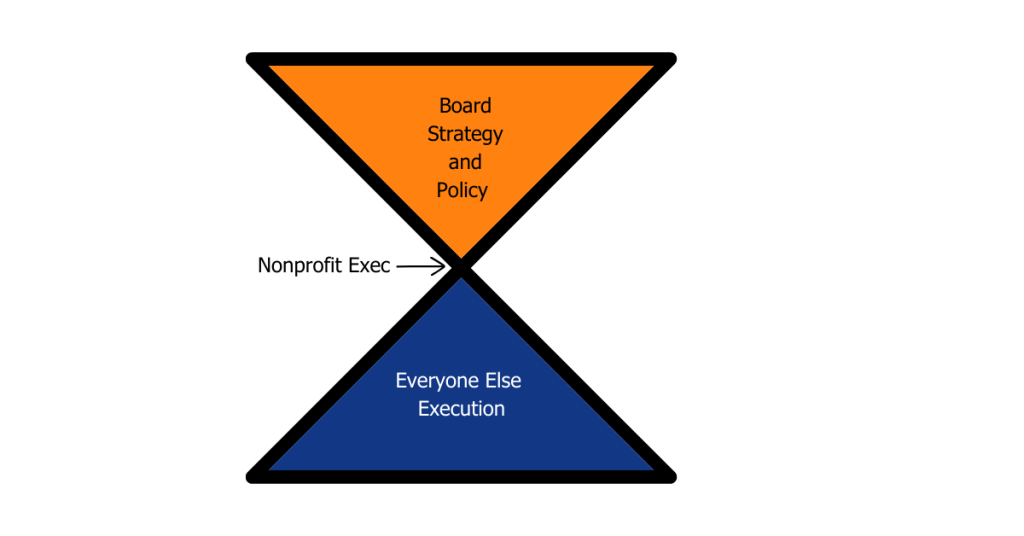
The Hidden Work of Nonprofit CEOs: The Essential Act That Drives Success
And, do you have what’s needed to get it done?
At first glance, the most valuable work of a nonprofit CEO or executive director seems like an easy question.
It’s not.
In one of Karen’s CEO Conversations, every exec gave a different reply to the question, ranging from managing the board to creating a joyful environment.
Think about it: What do you think is the most important work a nonprofit exec does? Here are some answers:
- Guide the staff to produce results.
- Grow board and community relationships plus visibility
- Controls finances and makes sure the operation runs smoothly
Since the three answers reflect high-value activities, perhaps you want a “4. All of the above.” Or, maybe you don’t see the answer you expected, so you’re looking for “5. Something else.”
This post discusses the most valuable work nonprofit execs do.
Why is Knowing What’s Most Valuable Worth Discussing?
If the exec’s unclear about their most essential work, it’s unlikely they’ll do it. And, if the team–by this, I mean the board, staff, and funders–aren’t clear, they won’t support it.
What Happens When the Exec and Others Don’t Know What’s Most Beneficial?
They don’t:
- Value it
- Schedule it and protect time for it
- Measure it, or
- Put it in job descriptions, so the board’s unlikely to hire for it.
With So Much To Do–Why Is One Task More Valuable Than Others?
This work
- Can’t be delegated.
- Interprets the strategy and vision into a coherent set of inter-coordinated activities
- Stands at the intersection that determines if you invest resources or burn them up
- Instills hope and inspires enthusiasm that tomorrow will be better than today when done well, and
- Inspires support that comes over the threshold. (Yes, fundraising and earning revenue are critical for nonprofits. However, the least labor-intensive income arrives unsolicited.)
With all that lead-up—let’s name the most valuable task nonprofit execs do. Drum roll–the answer is finding the future and guiding people to it.
High-functioning windfall-attracting CEOs see the pathway ahead.
These CEOs yell back to others, “Come on. It’s this way.” They figure out where to go next and lead everyone to it.
These execs
- plot a course that considers all the players
- coordinate specific steps
- take advantage of unexpected opportunities
- organize and synch tasks to create logical and emotionally satisfying results
For example, everyone at a nonprofit is engrossed in the upcoming construction part of a building.
However, the CEO is deep diving into planning the subsequent phases: the ribbon cutting, operationalizing the facility, and engaging capital donors in ongoing program support. They do all this thinking and planning while monitoring the construction and daily operations.
Wait! Isn’t this The Board’s Work?

The board creates or endorses the strategy. Most strategies get organized into an annual plan approved by the board.
On Monday morning, someone translates these concepts into actions. This someone is the exec doing high-value work. Their role places them in the sweet spot between ideas and reality.
The exec is like a commercial pilot. The airline sells tickets, organizes ground crew to load planes, and flight planners to plan flights. It’s the pilot who flies the plane. From the moment the doors close, the pilot (with help) is responsible for getting us to our destination.
What Does This Look Like to Volunteers, Staff, and the Board?
Like they’re following a tour guide with great foresight who’s taken the trip a lot.
Out of the office, the CEO, who has never been exactly this way before, may be just a few steps ahead of supporters. While CEOs showers, they play with coordinates, shuffle options, and formulate plans.
Think about it: Does your exec’s job description describe or refer to this work? Who finds the future and leads people to it at your nonprofit?
The Resources Exec Need to Do The Work
Just because you add a task to a job description doesn’t mean execs have what they need to do the work. Here are five necessary tools:
- A compelling vision and effective strategy
- Time to noodle, daydream, innovate, and learn
- Trusted advisors to run ideas up the flagpole. Advisors might be a significant other, board champions, peers, or consultants.
- Space to pilot ideas and gather data
- Confidence to cobble together a “good enough for now, safe enough to try” plan (see more for this sociocracy language here.)
Think About It: Which of these resources does your nonprofit exec have? What’s missing?
Skills and Experiences Needed to Find and Share The Future
Execs also need skills to identify and give people maps to the future. These include:
- An ability to formulate ideas, figure out what people will actually do, and sort out what’s next, while keeping everyone engaged
- The finesse to elegantly deflect pressures to hurry or slow down until the timing is right
- The skill to stand in occasional whirlwinds between board expectations and staff needs
- Delegation and teaching skills to explain tasks and how they matter
- Discernment to know when to listen to critics, accept slow conversion, or invite departure for those after a different destination
Think about it: Rank your current exec on these skills. Where are they strongest?
The Back Story
When most people talk about the nonprofit CEO job, they answer by listing operation tasks when asked, “What do you think is the most important work a nonprofit exec does?”
And, if you choose an operations task, you’re right. These are musts. You won’t attract windfall gifts or thrive without someone in the nonprofit executing these well. But operational responsibilities obscure the three most critical functions of the nonprofit exec, and the top one–finding and sharing the path to the future.
William Novelli, former CEO of AARP, said, “It’s harder to succeed in the nonprofit world. For starters, nonprofits’ goals are both more complex and more intangible.” Part of the challenge of complex and intangible goals is that it is difficult to figure out how to do them—a fact that points to the essential work of the nonprofit exec—finding the future and guiding people to it.
Think About It: Is future finding valued at your organization? How do you rank it ‘s important on the one to four scale, with four high?
***
You can keep up with me. Subscribe to my newsletter, Karen’s CEO Solutions.
Karen Eber Davis is a nonprofit strategic planning consultant who works with visionary leaders committed to taking their organizations to new heights. She offers customized strategies, assessments, and coaching designed to help leaders lead their organizations to achieve their potential. She is the author of 7 Nonprofit Income Streams and Let's Raise Nonprofit Millions Together.
Categories
If you appreciate these Added Value posts, please consider subscribing.
Latest Posts
- The Uncertainty Vortex: How Visionary Nonprofit Leaders Move Forward Without Clarity
- How New Nonprofit CEOs Secure Board Buy-In for Strategic Planning
- How Nonprofit Leader Navigate Crisis with Clarity & Confidence
- One Way AI Can Help You Find a Path Where None Exists
- In Crisis? Resist Cutting Your Ability to Make Income
